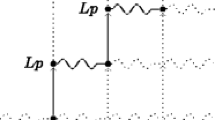Abstract
This paper provides a categorical equivalence between two types of quantum structures. One is a complete orthomodular lattice, which is used for reasoning about testable properties of a quantum system. The other is an orthomodular dynamic algebra, which is a quantale used for reasoning about quantum actions. The result extends to more restrictive lattices than orthomodular lattices, and includes Hilbert lattices of closed subspaces of a Hilbert space. These other lattice structures have connections to a wide range of different quantum structures; hence our equivalence establishes a categorical connection between quantales and a great variety of quantum structures.
Similar content being viewed by others
Notes
The existence of a join for every (potentially infinite) set guarantees the existence of a meetas well; the meet (greatest lower bound) of A is the join of the set of lower bounds of A.
The original function \(\bigsqcup \)is then the join operation on the lattice structure,from which the order relation can be recovered by\(x\sqsubseteq y\)iff x ⊔ y = y.
References
Abramsky, S., Vickers, S.: Quantales, observational logic and process semantics. Math. Struct. Comput. Sci. 3, 161–227 (1993). doi:10.1017/S0960129500000189
Baltag, A., Smets, S.: Complete axiomatizations for quantum actions. Int. J. Theor. Phys. 44(12), 2267–2282 (2005)
Bergfeld, J.M., Kishida, K., Sack, J., Zhong, S.: Duality for the logic of quantum actions. Studia Logica. 1–25 (2014). doi:10.1007/s11225-014-9592-x
Coecke, B., Smets, S.: The sasaki hook is not a [static] implicative connective but induces a backward [in time] dynamic one that assigns causes. Int. J. Theor. Phys. 43 (7–8), 1705–1736 (2004). doi:10.1023/B:IJTP.0000048815.92983.6e
Rosenthal, K.: Quantales and Their Applications. Longman Higher Education (1990)
Sasaki, U.: Orthocomplemented lattices satisfying the exchange axiom. J. Sci. Hiroshima Univ. A 17, 293–302 (1954)
Stubbe, I., van Steirteghem, B.: Propositional systems, Hilbert lattices and generalized Hilbert spaces. In: Engesser, K., Gabbay, D.M., Lehmann, D. (eds.) Handbook of Quantum Logic and Quantum Structures, pp 477–523. Elsevier Science B.V., Amsterdam (2007), 10.1016/B978-044452870-4/50033-9
Acknowledgements
We would like to thank Professor Roberto Giuntini for his suggestion that we consider orthomodular lattices rather than just Hilbert lattices in the equivalence. Kishida’s research has been supported by the grants FA9550-12-1-0136 of the U.S. AFOSR and EP/N018745/1 of EPSRC. Rafiee Rad’s research is funded by the European Research Council under the European Community’s Seventh Framework Programme (FP7/2007-2013)/ERC Grant agreement no. 283963. Zhong’s research is supported by NSSFC Grant 14ZDB015.
Author information
Authors and Affiliations
Corresponding author
Rights and permissions
About this article
Cite this article
Kishida, K., Rafiee Rad, S., Sack, J. et al. Categorical Equivalence Between Orthomodular Dynamic Algebras and Complete Orthomodular Lattices. Int J Theor Phys 56, 4060–4072 (2017). https://doi.org/10.1007/s10773-017-3433-4
Received:
Accepted:
Published:
Issue Date:
DOI: https://doi.org/10.1007/s10773-017-3433-4



